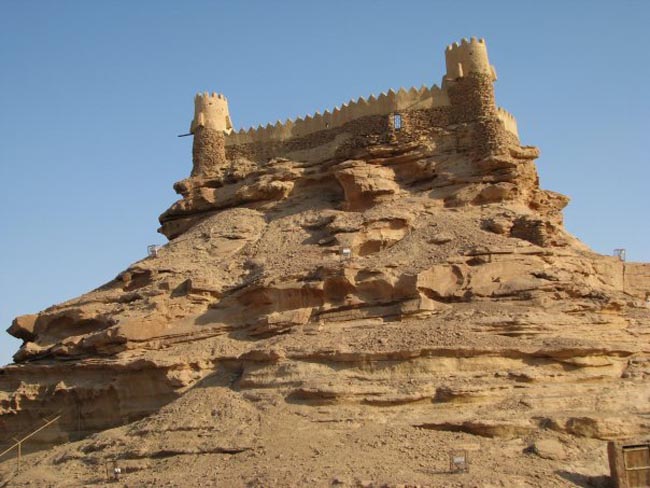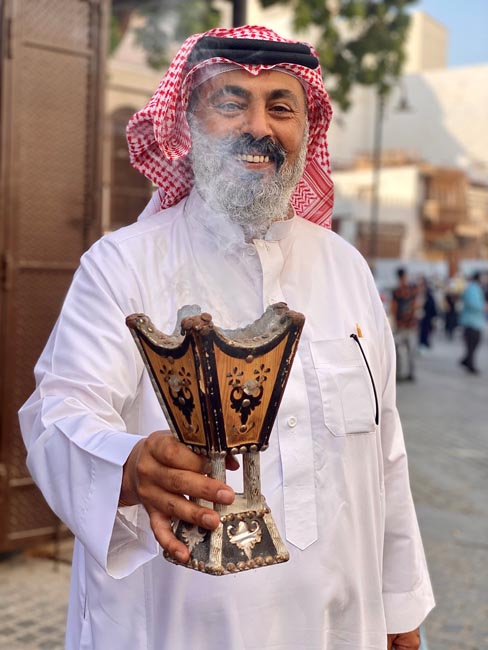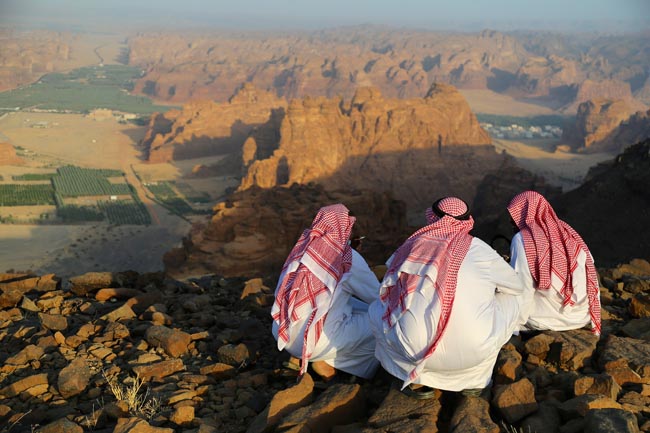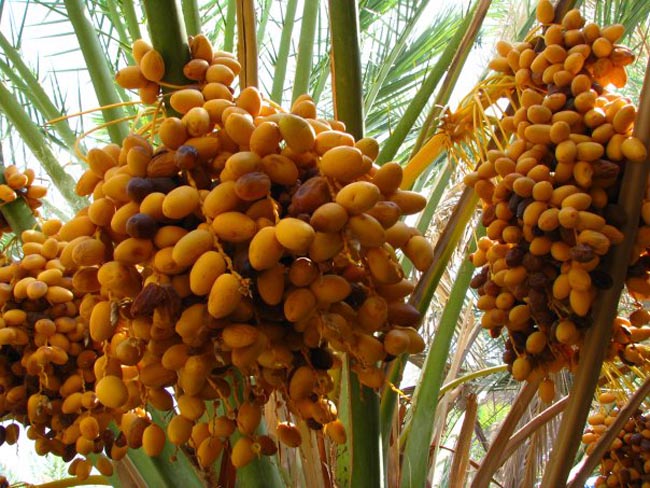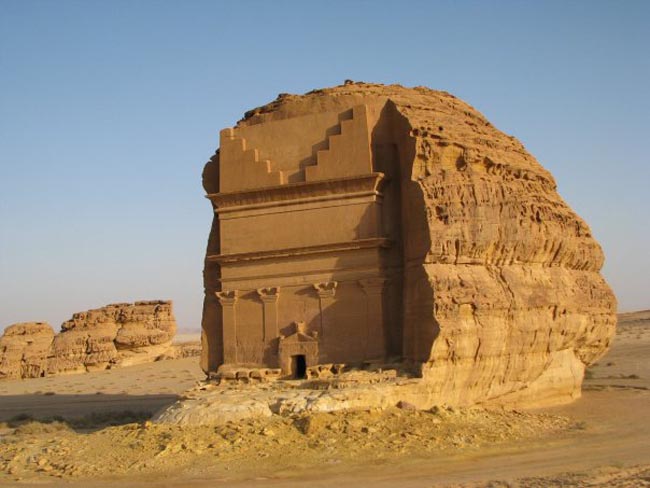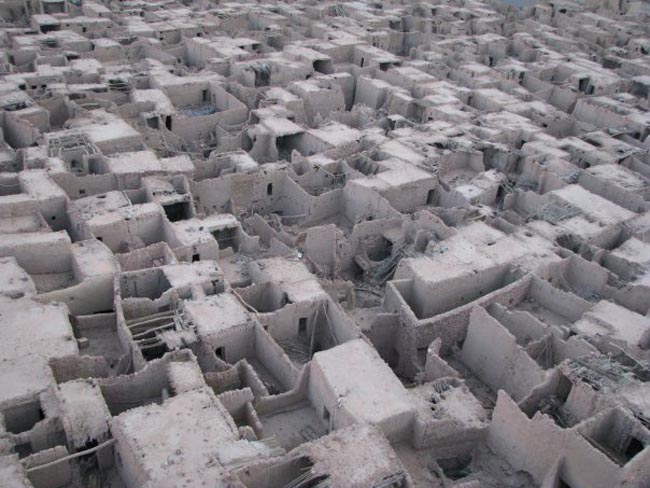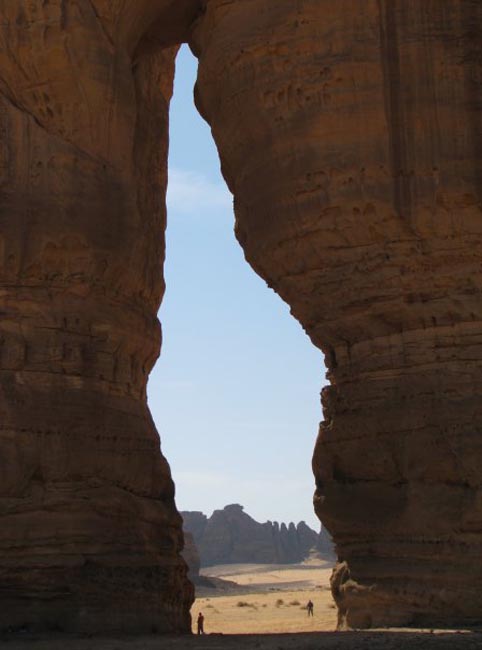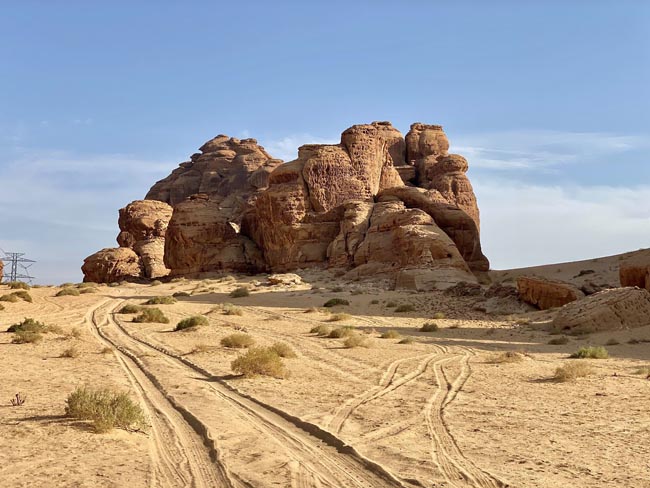We're pleased to be returning to the Kingdom of Saudi Arabia, with a refreshed itinerary and a greatly-simplified set of entry requirements. This, for many travellers, is the ultimate "off the beaten track" experience, in a country that has historically been closed to non-Muslim visitors. We have reunited with our old trusted local partners to craft a varied and exciting program that showcases all that this ancient land has to offer the visitor.
Prices below are per person, twin-sharing costs in US Dollars (USD). Pricing does not include airfare to/from the tour and any applicable taxes. For single supplement rates and taxes (if any), please refer to below Prices & Dates table. For general information on flights to/from the tour, click here.
Your Travel and Accommodation Arranged For You
Tips Included for Driver, Restaurant Staff, Local Guides
Authentic Local Experiences With Lots Of Inclusions.
Select a date below to reserve your spot:
Optional Single Supplement: $1540 USD (number of singles limited).
This tour may require a mandatory single supplement charge of $770 if you join our share program and we are unable to pair you.
Download Itinerary
Day 1 Arrival in Riyadh
Welcome to Saudi Arabia!
Riyadh, situated on a large plateau in the center of the Arabian Peninsula, is both the capital of Saudi Arabia and it's largest city. The name Riyadh is derived from plural of the Arabic word rawdha, which means "garden," particularly those formed in the desert after the spring rains. Riyadh has for more than 1500 years been a fertile area set in the heartland of the Arabian Peninsula. The settlement was historically famous for its palm trees, dates and orchards. Once a small walled city, Riyadh has developed into a dynamic metropolis over the years and has become a focal point for both travel and trade. One of the richest and splendid cities in this modern era, this is truly the heart of the Arab world.
Overnight in Riyadh.
Included Meal(s): Dinner
Day 2 Riyadh: City Tour
Considering that at the turn of the 20th Century there were no main roads leading into Riyadh, this desert capital has come a long way. Although Riyadh has always been the base of the ruling Al-Sauds, it was only in the 1970's that ministries and embassies relocated from the more cosmopolitan city of Jeddah to the traditional capital of Riyadh. Much of Riyadh has been constructed since the boom years of the 1970's.
In addition to being the centre of power, the city is also a commercial hub. Numerous educational, financial, agricultural, cultural, technical, and social organizations have set up base here. The architecture is mostly modern, including contemporary high-rise towers and spacious, air-conditioned malls. The Al-Diriyah district, located to the northwest corner of the modern city, is the original seat of power of the Al Saud family. It has been recently rebuilt in a style meant to evoke the old pre-20th century mud-brick buildings that once existed. Now a focal point for Riyadh tourism, we will take the opportunity to visit the UNESCO-listed site of At-Turaif and explore its winding alleyways.
Our full day of sightseeing will also include a visit to the Masmak Fortress, a very important historical monument in Riyadh. Located in the centre of the modern city, this fortress and museum symbolizes the unification and foundation of the Kingdom of Saudi Arabia. When passing through the new part of city we will view the Al-Faisaliah Tower and visit the Kingdom Tower.
Overnight in Riyadh.
Included Meal(s): Breakfast and Dinner
Not finding what you're looking for?
Our specialists can take away the stress and create a private custom tour tailored to your exact interests and budget.
Day 3 Riyadh - Train to Hofuf & Al-Hasa Oasis
This morning we travel by train to from Riyadh to Hofuf.
Hofuf is one of the major cultural centers in Saudi Arabia, and is the major urban center in the huge Al-Hasa Oasis. The area is dotted with date palm farms, and it is these agricultural farms that make al-Hasa the largest oasis in Saudi Arabia. Hofuf was the capital of the Eastern Province until 1953 and various parts of the old town still show evidence of when the Ottoman Empire controlled most of the area. There are several landmarks of its distinguished past, and here one can find an old fort and one of the most interesting souqs in the Kingdom. Today a lot of well-known families live nearby, and the majority of the population is Sunni. The faculties of agriculture, veterinary medicine and animal resources of the King Faisal University are located in the city (the others being in Dammam). The Hofuf campus also has facilities where Saudi women can study medicine, dentistry, and home economics.
In ancient times, Al-Hasa was at the center of the trade routes which traders followed between the east of the Arabian Peninsula and India, Persia and the Far East. Al-Hasa has been inhabited since prehistoric times, due to its abundance of water in an otherwise arid region. Because of the enormity of the oasis and the number of picturesque villages scattered through it, we will enjoy a drive through the greenery during part of our visit.
The balance of our day will be spent exploring the region, and our sightseeing will include a visit to the Jabal al-Qarah, or al-Qarah Mountain, added to the UNESCO world heritage list in 2018. At this location we will explore a small on-site museum “Land of Civilizations”, featuring displays on the area’s ancient history. The main attraction of the mountain is the cave complex that we will explore. Cracks and fissures have formed as a result of sub-aerial weathering, where water and rain have gouged out the limestone rock into cave passages. Local legends amongst the ex-pat Filipino community here suggests that these were the caves that Judas Iscariot hid after betraying Jesus.
Our sightseeing will also include Qasr Ibrahim Fort, built in the 16th century by the Ottoman Governor of the time. The Fort is often closed due to the whim of the local caretakers so our visit may be only an outside view. Nearby here is the souq, and this covered market is home to the 'women's souq', and is one of the biggest shopping centers of the area. One can find a great variety of items ranging from gold to textiles, with specific and shops for women.
Overnight in Hofuf.
Included Meal(s): Breakfast and Dinner
Day 4 Al Khobar - Dhahran - Fly to Ha'il
This morning we travel north to the modern city of Dhahran, which lies on a strip of land that stretches out into the Persian Gulf. This is a thriving modern economic hub and a major seaport. With the continuing expansion of all parts of the Kingdom, three towns inevitably merged into one, creating a single municipality known as Dhahran Area. Near Dhahran are located the most important centres in the world for the production and refining of petroleum. With the discovery of oil in March 1938, the fortunes and lifestyle of the people of Arabia changed dramatically.
Upon arrival to Dhahran we will visit the King Abdulaziz Center for World Culture, which, among other things, exhibits international and local exhibitions that shed the line on the developing and modern art movement and the rich historical roots and in Saudi Arabia.
Later we travel the short distance to the airport at Damman from where we fly to Ha'il (via Riyadh). This may result in including lunch instead of dinner today; your Tour Leader will advise.
Overnight in Ha'il.
Included Meal(s): Breakfast and Dinner
Day 5 Ha'il Sightseeing - Jubbah - Sakaka
This morning we visit Ha'il, situated in the Shammar Mountain region, west of the Al-Odairie Valley (also known as the Ha'il Valley). Traditionally the Ha'il Valley derived its wealth from being on the camel caravan route of the Hajj, and the city grew because of its location on this pilgrimage route from Iraq. The opening of the Hejaz Railway between Damascus and Medina, together with new inexpensive steamship routes to Jeddah, undermined the traditional camel caravan economy of Ha'il. Today Ha'il has been transformed into a modern city.
There are many gardens and landscaped areas within the city, as well as several historic palaces and fortresses (some dating the Ottoman era). Ha'il is also known for its agricultural products (including vegetables, fruit, wheat and barley), and is the centre of Saudi Arabia's agricultural program. We will tour the city of Ha'il, where our sightseeing includes the old fort, A’arif, situated in a prominent position overlooking the old city, with a commanding view of the surrounding desert terrain and the mountains of Jebel Selma and Aja. Sitting below the fort is a quirky, but interesting, local heritage museum featuring a wide variety of Saudi antiques.
We continue toward Sakaka, through the Nafud Desert, connected to the Empty Quarter by a "sand corridor." En route we will make a stop at Jubbah, surrounded by large sandstone outcrops that are filled with ancient petroglyphs and inscriptions on the rock face. Some of these rock carvings show men wearing headgear, birds, monkeys, gazelles, and two animals pulling a wheeled cart.
Overnight in Sakaka.
Included Meal(s): Breakfast and Dinner
Day 6 Sakaka Area Touring
Today we tour Sakaka and Al-Jouf (Dumat al-Jandal).
Sakaka and Al-Jouf are adjacent oasis towns in the northern part of the Kingdom on the old caravan route from the Mediterranean to the south of the Arabian Peninsula. This is Saudi Arabia's northern gateway, linking Syria and Iraq with the Arabia peninsula. It is the cradle of the Nabatean and Assyrian cultures.
The Bir Sisra well in Sakaka is believed to be belong to the Nabatean period. Local people said that some areas of Sakaka town as well as the land to the south and East were once irrigated from this well by means of underground channels. The Qasr Zabal citadel / fortress is located on the northern edge of the town.
Jouf is of particular interest because of the role it has played in pre- and post-Islamic history. There is archeological evidence of the presence of the Assyrians and Nabateans in Jouf. Following its conquest by Muslims in the third year of the Hijira, it became a staging post for Muslim armies, setting out to spread the message of Islam, while remaining an important crossroads for traders and their caravans heading to or from Iraq and Syria into the Arabian Peninsula. Today, the cultivation of palms constitutes the main agricultural sector, as well as wheat and a wide variety of fruit and vegetables, including grapes, figs, olives, potatoes and tomatoes.
Our sightseeing in and around Jouf will include a tour of the old city. Qasr Marid is a walled fortress that overlooks the ancient town. Umar Mosque is located next to the Qasr Marid, and was built at the time of the second caliph, Umar Bin Al Khatab, who passed through the region on his way to Jerusalem. We'll also see the Old City and museum at Dawmat al-Jandal, where we find the Umar Mosque and the Qasr Marid.
Overnight in Sakaka.
Included Meal(s): Breakfast and Dinner
Day 7 Sakaka - Tabuk Touring
Today we travel to Tabuk.
From snowy mountains to the deep blue sea, the province of Tabuk in Saudi Arabia is home to some of the most varied natural landscapes in the country, offering possibilities for beach holidays, island hopping, Red Sea diving, mountaineering and, of course, sightseeing. The region holds some of the nation’s highly treasured historic and archaeological sites, a rich heritage left behind by ancient civilizations of foregone eras.
Tabuk is situated amid a grove of date palms. In former times it was a station on the Hejaz railway (now defunct). At the edge of the old part of Tabuk stands a Turkish fort, built in 1694. Present-day Tabuk is one of the fastest-growing industrial centres of Saudi Arabia.
Tabuk's early-20th-century Hejaz Railway station is one of the best-preserved in Saudi Arabia. There are 13 recently refurbished buildings spread over 80,000 sq metres and these include a workshop, a handicrafts centre, and a building that houses a locomotive, a freight car and several Ottoman relics worth viewing. The Hejaz Railway was a narrow gauge railway that ran from Damascus to Medina, through the Hejaz region of Arabia, with a branch line to Haifa, on the Mediterranean Sea. It was a part of the Ottoman railways network and was built in order to extend the previously existing line between Istanbul and Damascus all the way to the holy city of Mecca (eventually being able to reach only Medina due to the interruption of the construction works caused by the outbreak of World War I). The main purpose of the Hejaz Railway was to establish a connection between Istanbul, the capital of the Ottoman Empire and the seat of the Islamic Caliphate, and Hejaz in Arabia, the site of the holiest shrines of Islam and the holy city of Mecca.
Dating to 1559, Tabuk Fort is now a museum, with several rooms housing some interesting historical artifacts from the Ottoman period and lots of signage about the history of Tabuk, its connection to the Prophet Muhammad and several famous travellers. The castle features a ground-floor mosque, an open courtyard and a stairway to the castle’s 2nd-floor mosque, and watchtowers. Outside are cisterns that once captured water from a spring that the Prophet Muhammad reportedly drank from.
We'll see the At Tawba Mosque (from outside), where the Prophet Muhammad prayed when he arrived with 30,000 men in AD 630 for the Battle of Tabuk against the Byzantines. The battle never took place but, while here, the Quran's ninth chapter, Surah At Tawba, was revealed. At Tawba Mosque was originally made of bricks, mud and palm-tree trunks. The Ottomans rebuilt it in 1652.
Overnight in Tabuk.
Included Meal(s): Breakfast and Dinner
Day 8 Tabuk: Neom Tour
Today we will drive west from Tabuk towards the Red Sea through the Bajdah Desert. This is the region that the NEOM megaproject project, the Line, is being constructed in.
For most of the day we will see beautiful rock formations such, as Ship Rock. Many of these mountains are covered in petroglyphs. Our journey will take us in the footsteps of Moses, where we will see the mountain that locals and some scholars believe is the Mt Sinai where the 10 Commandments were revealed. We will also visit the Altar of the Golden Calf, where Moses' people began worshipping an idol while we was away. Here we will see many bovine petroglyphs.
At the Red Sea, we will stop at Sharma where we will have lunch and visit the seaside corniche.
Later, once it opens towards the evening, we will visit Magha'er Shuaib and the tombs at Madyan. Here we will see houses and tombs cut from the rocks dated to more than 2000BC. This was the home of Shuaib, Moses' father-in-law. Later, the Navateans decorated the area further. We can walk among and explore inside some of the tombs.
Overnight in Tabuk.
Included Meal(s): Breakfast and Dinner
Day 9 Tabuk - Wadi Al-Disah Excursion - To Al-Ula
Today we leave Tabuk travelling to Al-Ula with a 4x4 excursion into Wadi Al-Disah, a 15 kilometer long canyon running through Jebel Qaraqir, a sandstone massif lying about 80 kilometers south of the city of Tabuk. This natural wonder was for a long time a well-kept secret among explorers, before the road leading to the nearby city of Disah was built and satellite images were available to the public. Today, there are two roads leading to each entrance of the wadi and this natural wonder has become one of the must-see places in Saudi Arabia.
The first striking feature of this wadi is its dimensions: at the eastern entrance of the canyon the side cliffs are already higher than 100 meters, but at the western entrance the gap between the bottom of the wadi and the tallest cliffs reaches as high as 500 meters! It is there, from the massive rocky peaks standing on both sides of the canyon, that one can admire the most dramatic scenery of this magical place. The second - and most unexpected - amazing feature of the wadi is a water stream that runs through the western part of the canyon towards the city of Disah.
We continue to Al-Ula, passing several villages en-route. This journey west follows along some amazing rock formations and some great desert sites where we may have opportunities to take photos of camel herds wandering in the vast desert. The Al-Ula Oasis was located on the incense route and was the capital of the ancient Lihyanites. Today, Al-Ula is located in the heart of a beautiful corner of Saudi Arabia, on the west side of a narrow palm-lined wadi.
Al-Ula has a rare combination of striking geography, ancient history, ethnography and nature that makes this a fascinating place to visit. This is a rare example of an Islamic city, which dates back to the 11th Century AD.
Overnight in Al-Ula.
Included Meal(s): Breakfast and Dinner
Day 10 Al-Ula & Madain Saleh
Madain Saleh, which rises up from the sands in a landscape of real beauty, dates back to the Nabataean civilization and is considered to be one of the most important archaeological sites in Saudi Arabia. The Nabataeans were an ancient trading people whose oasis settlements gave the name of Nabatene to the borderland between Syria and Arabia, from the Euphrates to the Red Sea. This "Capital of the Monuments" is home to over 130 tombs, many dated to between the 2nd century BC and the 2nd century AD. Inscriptions engraved on rocks, facades of graves and mountains provide evidence of the existence of civilizations that had prevailed and fallen in this area. The Kingdom of Nabataeans, with its capital Petra in Jordan, expanded to dominate Madain Saleh, their second city. The landscape here of sweeping sand and wonderful rock formations is stunningly beautiful. The tombs are also in an excellent state of preservation, due largely to the fact that the local stone is much harder than that found at Petra.
Our sightseeing of this extraordinary site will include an early morning visit to some of the most important tombs with the local Royal Commission for Al Ula (RCA) Governate, “Experience Al Ula”. The RCA has been established to protect the heritage of Al Ula and sustainably develop the tourism facilities of the region . They have exclusive access to the Hegra site that protects the majority of the tombs in the area. We will see the famous Qasr al-Farid tomb, a spectacular carved piece of rock standing alone in the desert, as well as the rock construction known as Al-Diwan, likely used for Nabataean ceremonies. We will also view Qasr al-Bint and the Hejaz Railway Station #21 as part of the morning activities.
Once we are back on our own bus, we will do visit some locations closer to the town of Al Ula itself. During our time in Al Ula, we will have a walk through the old town, now being developed by the RCA into a tourist hub filled with cafes and local handicraft stores that feels like a walk back through time.
We will also be able to view the magnificent Al-Khuraybah tombs; here are some extremely well-preserved tombs that are cut into the face of a cliff. Our adventure will also include a stop at Elephant Rock.
Overnight in Al-Ula.
Included Meal(s): Breakfast and Dinner
Day 11 Al Ula - Medina
Today we have a half-day drive across the desert landscape from Al Ula to Medina. Medina is one of Islam's two most holy cities. The Prophet Muhammad lived and taught in Medina after departing Mecca in the year 622 AD. His arrival in Medina marks the beginning of the Islamic Calendar. Medina, or Medina al Munawwarah, means "the Enlightened City". The key focal point of the city is the Masjid an Nabawi or the "Prophet's Mosque," constructed by Muhammad and also the site in which he is buried.
We hope to be able to get close to the mosque for exterior photos but due to the cultural sensitivity of a city that, up until very recently, was closed to non-Muslims, we will proceed based on the local guide's first-hand information at the time on whether this would be appropriate.
We overnight in Medina in order to take the high-speed train to Jeddah the following morning.
Overnight in Medina.
Included Meal(s): Breakfast and Dinner
Day 12 Medina - Train to Jeddah
This morning we will take the high-speed train on the Haramain Railway. Recently completed in 2018, it connects the holy cities of Medina and Mecca, via the port city of Jeddah. Our destination today is Jeddah and the journey should take just over an hour.
Located on the Red Sea coast, Jeddah is the principal gateway to Mecca, Islam's holiest city. Founded as a fishing hamlet over 2,500 years ago, today Jeddah is the commercial capital of Saudi Arabia. This city first truly came to light in 647 AD when it was turned into a port for Muslim pilgrims making the required Hajj to Mecca.
Jeddah has been mentioned in many ancient travellers' journals and texts, some describing it as "the city surrounded by walls with beautiful markets and teeming with buildings," whilst others described it as "the small city on the Red Sea coast crowded with pilgrims". It seems as though there have always been inns, caravanserais, and hostels catering to travellers and pilgrims.
We will aim to complete some of our Jeddah sightseeing in the afternoon after transferring to the hotel from the railway station.
Overnight in Jeddah.
Included Meal(s): Breakfast and Dinner
Day 13 Jeddah: City Tour
Jeddah -- "Where desert and water meet rises the gateway to Islam, a city of life and a crossroad of culture."
This city has grown from humble origins. In AD 647, Caliph Osman Ibn Affan chose Jeddah as the main port for the city of Mecca (Makkah), and it became known as Bilad al Kanasil -- the City of Consulates. In the 16th century, the Ottomans built a stone wall around the town in order to fortify it against attacks from the Portuguese. Jeddah remained a fortified, walled town for centuries of Ottoman influence and was not released from Turkish rule until 1915. The buildings of old Jeddah were tall and graceful, constructed of coral limestone and decorated with intricately beautiful wooden facades, known as ‘rawasheen.’ These were designed not only to break up the sun's glare, but also to take advantage of the cooling sea breezes when the inner windows were opened. One cannot help but feel that, with the enclosure of the town within high, fortified walls, the sea breezes may not have stood much chance of reaching Jeddah's early inhabitants; hence their penchant for building their houses tall and for sleeping on the roofs on hot summer nights.
Our sightseeing tour today will include a walking tour around old Jeddah (Al-Balad). In bygone days, the streets of Old Jeddah were twisting, unpaved and haphazard, flanked by closely-packed buildings. A thick layer of sand covered these streets, packed solid by numerous tramping feet. Mingling with the strolling inhabitants, water carriers and other street vendors, camel caravans once plodded their way through the wider thoroughfares, while goats and donkeys wandered in the narrow alleys.
We will be sure to visit the bustling Alawi Souq, the heartbeat of Old Jeddah and still an exciting and picturesque part of today's city. Traditionally the open-fronted shops were grouped together according to trade; an old Oriental bazaar tradition, which has continued into modern life. Wares were displayed in the street under palm-leafed canopies, sheltering traders from the relentless sun -- a far cry from the modern-day comforts of air-conditioning in the luxurious shopping malls of today.
We'll also visit an extremely eclectic museum, Al Tayebat International City, which features an almost bizarre collection of every type of historical object in a reconstructed Old Jeddah style building.
In the evening we will drive along the Corniche, a cultural landmark of the city. After the Maghreb (sunset) prayer, the Corniche springs to life, with Saudi families dining al fresco. Picnicking seems to be a favourite local hobby, and is regarded as an ideal opportunity to get together for a family chat and a substantial supper.
Overnight in Jeddah.
Included Meal(s): Breakfast and Dinner
Day 14 Departure
Departure from Jeddah.
RHLAH S'IDAH / BON VOYAGE!
Included Meal(s): Breakfast
Inclusions
Breakfast and dinner daily.
All transport (including local flights), accommodation, sightseeing and entrance fees for sites noted as 'visited' in the detailed itinerary.
Gratuities for drivers, restaurant staff, porters, local guides.
Airport transfers for land & air customers and for early arriving/late departing land & air customers who also book their extra hotel nights through us.
Exclusions
International airfare to/from the tour.
Tour Leader gratuities, lunches, personal items (phone, laundry, etc), international (if applicable) air taxes, visa fees*, and any excursions referenced as 'optional'.
Option single supplement.
Airport transfers for Land Only customers.
Optional trip cancellation insurance.
* Visas: Tourist e-visas are now available online through https://visa.visitsaudi.com/ The application does not ask for information pertaining to your religion; in the past any evidence of a previous visit to Israel would exclude you from entry to Saudi Arabia, but this has now changed.
Seasonality and Weather
Saudi Arabia is an extremely dry country and rainfall is minimum. In summers, the country witnesses blistering heat and humid temperatures, thus making it uncomfortable to get around. From November onward the weather is welcoming; however, nights are quite chilly but you can easily explore comfortably during daytime.
Fall (September through November):
Fall daily highs range from 25C to 40C (77.4°F & 104.4°F), which seems hot but humidity is low and breezes are common. It rains a barely noticeable amount: 0 to 1 days per month.
Winter (December through February):
Weather is somewhat cool this time of year; the average high during this season is between 20C (69°F) and 26C (80°F). On average, it rains or snows a very small amount: 0 to 1 times per month.
Transport and Travel Conditions
Ground transport provided by private air-conditioned motor coach; in Wadi Al-Disha we'll have a 4x4 excursion on dirt/sand roads.
The tour is not strenuous though it is busy; you must be steady on your feet and be able to endure some heat and long travel days. We have numerous walking tours and visit several sites that are LARGE with steps and uneven surfaces. You must be independent with your own luggage at airports (porters are available at hotels).
Our difficulty rating "Level 2" refers to the ambitious nature of the itinerary and the lots of moving around that we do. Some days are long and we may have some early starts. Some mountain roads are also winding; those sensitive to motion may be affected.
Saudi Arabia has recently relaxed its restrictions for foreign women visiting the country. Though your dress and overall appearance must be conservative, with shoulders, arms and legs covered (the same for men), foreign women no longer need to wear the 'abaya' -- the loose robe-like over-garment. They have also lifted restrictions on women arriving alone (ie without a husband or family member), and on unmarried women and men sharing a hotel room.
Please be aware that most places in the Kingdom shut down between noon and 3 pm every day, as well as several other times during prayers, and often the group will be returned to the hotel for some free time during these periods. Sites can also be closed for no foreseen reasons or authorities can also deny visit of certain places without prior notice for which we are not responsible. Some drives can be long and monotonous, crossing vast expanses of desert with nothing much to observe along the way, a necessary drawback to cover a large territory; we use internal flights and a fast train to reduce some of this dreary driving.
Am I suitable for this tour? Please refer to our self-assessment form.
Activity Level: 2
These are particularly busy tours that feature a lot of moving around, sometimes by train and short journeys on local transport. Walking tours of towns and cities are leisurely but you should be prepared to be on your feet for several hours. Some of our cultural trips that occur at high altitude and/or require greater independence with baggage handling (at hotels, airports, train stations) also fall into this category.
To learn more about the Activity levels, please visit our tour styles page.
Accommodation
Our accommodation choices are modern, well-appointed 3-4 star properties. Our tented village at Al-Ula is a unique and comfortable desert experience with all the "creature comforts." Porters are generally available (see 'Inclusions').
A mandatory single supplement may apply to this tour if you have selected our share program and we cannot find you a share partner.
Please refer to the 'Map & Hotels' tab for more information.
Staff and Support
Tour Leader throughout, local drivers, local guides at various locations.
Group Size
Maximum 18 plus Tour Leader
Regions visited: Middle East
Countries visited: The Kingdom of Saudi Arabia
*The red tour trail on the map does not represent the actual travel path.
The following is a list of sample hotels at some locations included on this tour. The hotels shown here are meant to provide a general sense of the standard of hotel we usually aim for; they are not necessarily confirmed for your chosen departure.

















The camp does not have an official website.




Tourcode: KS1





